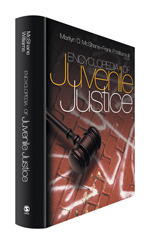
Encyclopedia of Juvenile Justice
- Marilyn D. McShane - University of Houston, Texas, Prairie View A&M University, Texas
- Frank P Williams III - Professor Emeritus in Social Work, California State University, San Bernardino, Prairie View A&M University, Texas
"The contributors consistently present complex material with a readable style relatively free of technical jargon. Accordingly, this outstanding reference work is highly recommended for school and public library collections, as well as academic libraries and criminal justice collections."
--REFERENCE & USER SERVICES QUARTERLY
"There is no comparable work. Useful for anyone doing research in the field of juvenile justice. Highly recommended."
--CHOICE
"What makes this work truly usable is its wonderful indexing and exceptional bibliographies. . . . If juvenile interaction with the judicial system is a research topic at your school, this volume is one of the best sources."
--LIBRARY MEDIA CONNECTION
From boot camps to truancy, the Encyclopedia of Juvenile Justice provides more than 200 up-to-date, concise, and readable entries in a single, authoritative volume. The editors, noted authors of several criminal justice books and editors of the award-winning Encyclopedia of Prisons, cover historical and contemporary theories, concepts, and real-world practices of juvenile justice in the United States.
The entries address a broad range of issues and topics, such as alcohol and drug abuse, arson, the death penalty for juveniles, computer and Internet crime, gun violence, gangs, missing children, school violence, teen pregnancy, and delinquency theories. In addition, topics cover society's response to the problems of juvenile justice, punishments meted out to America's juvenile offenders, juvenile rehabilitation programs, and well-known researchers and professionals in the field.
Key Features
- More than 200 articles, written by a stellar collection of academic theorists and real-world practitioners
- Complete review of the complicated juvenile legal and court system, juvenile punishment, rehabilitation efforts, and legislation
- Extensive entries on child and adolescent crimes, pathologies, and problems
- Coverage of psychological, biological, and sociological theories of delinquency, as well as historic "body type" theories
- Addresses such historical topics as the deinstitutionalization movement, the Chicago Area Project, and the Provo Experiment
- Profiles historic theorists and policymakers in juvenile justice
- Includes a special appendix on print and electronic resources on juvenile justice
- Comprehensive index, including a reader's guide that facilitates browsing and offers easy access to information
Recommended Libraries
Public, academic, school, law/legal, special, and private/corporate
“There is no comparable work. Useful for anyone doing research in the field of juvenile justice. Highly recommended.”
“What makes this work truly usable is its wonderful indexing and exceptional bibliographies. . . . If juvenile interaction with the judicial system is a research topic at your school, this volume is one of the best sources.”
"The contributors consistently present complex material with a readable style relatively free of technical jargon. Accordingly, this outstanding reference work is highly recommended for school and public library collections, as well as academic libraries and criminal justice collections."
"This attractively produced Encyclopedia, with many well-written and informative articles, will surely be a useful resource for any party seeking basic information on a range of topics related to juvenile delinquency and juvenile justice. It can be recommended for purchase by public libraries as well as college and university libraries and those serving a scholarly community with an interest in juvenile justice issues."
"This new reference guide explores these historical trends and the nature of the juvenile justice process today. From Edwin Sutherland to Marvin Wolfgang, the research and writing of leading theorists in juvenile criminology is examined. . . . The entries emphasize the research foundations of juvenile justice theory and provide numerous suggestions for further research. Although aimed at an academic audience, this guide will also serve public libraries."
